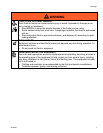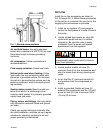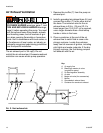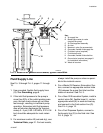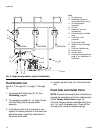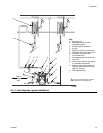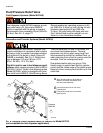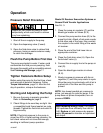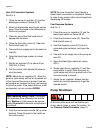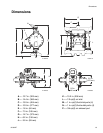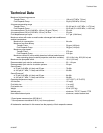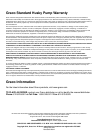
Operation
16 313597E
Gear Oil Evacuation Systems
See FIG. 4.
1. Close the pump air regulator (C) and the
bleed-type master air valves (B, E).
2. Attach an appropriate wand to the suction
hose. Place the wand in the differential or
fluid to be pumped.
3. Place the end of the fluid hose into an
appropriate container.
4. Close the fluid drain valve (H). Open the
fluid shutoff valve (J).
5. Connect the air supply line to the pump air
inlet (D).
6. Open the bleed-type master air valves
(B, E).
7. Set the air regulator (C) to about 50 psi
(350 kPa, 3.5 bar).
8. Pull the control valve handle (M) down to
start the pump.
NOTE: Adjust the air regulator (C). Allow the
pump to cycle slowly until all air is pushed out
of the lines and the pump is primed. Use low-
est possible air pressure to prime, just enough
to cycle the pump. If the pump does not prime
as expected, turn air pressure DOWN.
9. Push the control valve handle (M) up when
finished. Place the wand in the holder on
the control valve.
NOTE: Be sure the control valve handle is
closed when evacuation is completed. Failure
to close it may prevent other service bays from
developing full suction.
Fuel Dispense Systems
See FIG. 5.
1. Close the pump air regulator (C) and the
bleed-type master air valves (B, E).
2. Close the fluid drain valve (H). Open the
fluid shutoff valve (J).
3. Hold the dispense valve (X) firmly to a
grounded metal container, and open the
valve.
4. Connect the air supply line to the pump air
inlet (D).
5. Open the bleed-type master air valves
(B, E).
6. Slowly open the air regulator (C) until the
pump starts to cycle. Allow the pump to
cycle slowly until all air is pushed out of the
lines and pump is primed.
7. Adjust the air regulator. Always use the
lowest air pressure necessary to get the
desired results.
Pump Shutdown
At the end of the work shift and before you
check, adjust, clean or repair the system, fol-
low Pressure Relief Procedure, page 15.
NOTICE
When replacing Husky 1040s: The Husky
1050 operates more efficiently than did the
1040. Reduce air inlet pressure by approxi-
mately 20 percent to maintain an equivalent
fluid output.



